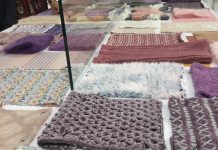
A new report from the financial think tank Planet Tracker investigates the magnitude of the financial and environmental impact of wet processing on the fashion industry and its investors, and the ways in which its key stakeholders can help ensure a just transition to sustainability.
Water is crucial in textile production. Wet processing in particular – which involves bleaching, dyeing and printing fabrics – is heavily reliant on clean freshwater and has become a significant contributor to impairing this already-stressed resource. While fashion brands have the power to motivate supplier behaviours through their buying practices to protect their sustainability credentials, opaque and complex supply chains mean it is often difficult to link the fashion brands to the wet processors causing harm.
The textiles industry is notorious for its disproportionate environmental damage and the wet processing stage is a significant driver of the majority of its negative environmental impact –requiring an estimated 430 litres of water to produce just one kilogram of fabric. Critically, for the 740 publicly listed companies directly involved in wet processing activities identified in Planet Tracker’s report, the majority of their factories are concentrated in emerging markets with high water stress (principally India, Pakistan and China), and, consequently, subject to significant water risk.
By layering wet processing factory geolocation data and water risk scores, Planet Tracker linked 230 of these wet processing companies – with a combined market cap of US$586 billion, to investors. Given their aggregate investment of $8billion in wet processing, the report found that individual investors and families were the most heavily exposed, with 67% suffering from “extremely high” or “high” water risks. Institutional investors too, are significantly exposed, with Planet Tracker’s analysis indicating that asset managers and financial conglomerates have aggregate investments in publicly listed wet processing companies of approximately $66 billion.
While their investments are often more geographically diversified than those of families and individual investors, thereby reducing their exposure to concentrated water risk, Planet Tracker identified 10 asset managers, including Vanguard, with medium-high water risk in their portfolios.
According to Planet Tracker, water-related risk extends beyond just posing a physical threat to operations – it also represents regulatory and legal risks, as well as market and transition risks, including changing consumer preferences and reputational damage. If water-related risks materialise in jurisdictions with high concentrations of wet processing companies, the cost of water will rise too. Because of the fragmentation of the supply chain supporting the multibillion-dollar fashion industry, these water-related risks are largely hidden from view from investors and lenders and, as such, are not fully priced in from an equity or credit perspective.
“Given wet processing companies are in a comparably weaker financial position, the power to enact change lies further downstream with fashion brands to enhance supply chain visibility, environmental accountability and product traceability,” said Peter Elwin, Head of Textiles Programme at Planet Tracker. “Investors, too, have significant influence to demand higher-quality data, particularly from these brands, so that they can better quantify portfolio risks and protect the rapidly depleting resource which underpins both their investments and our planet.”
With this in mind, the paper concludes with recommendations for fashion brands, as well as asset owners and lenders to help facilitate a just transition to sustainability.
For fashion brands:
Extend supply chain disclosures beyond Tier-1 suppliers to ensure they are environmentally accountable and verifiable, through the use of tools such as the Open Apparel Registry.
Align OECD guidelines with both their buying and sustainability policies, and support suppliers in publishing verified environmental data disclosures.
Finance investment in new technologies and machines, as well as improved access to renewable power sources within the wet processing sector, which lacks the financial strength and R&D facilities to develop new techniques. Wet processors must also make verifiable improvements in water usage and treatment as “proof of work”.
For asset owners and lenders:
Encourage fashion brands in their portfolios to develop transition strategies for their supply chains that protect jobs and communities, as well as the environment.
Pressure index providers to take the natural capital impacts of the textile industry into account when constructing their indices – or consider developing their own natural capital benchmarks.
Engage with intermediaries providing debt finance to the wet processing companies to influence them towards more sustainable practices.
The full report – Will Fashion Dye Another Day? Water-related financial risks in the textiles sector – is available.
See also, New green fibres, dirty old processes, interview with imogo on Innovation in Textiles here.

Subscribe To Our Newsletter
Join our mailing list to receive the latest news and updates from our team.













